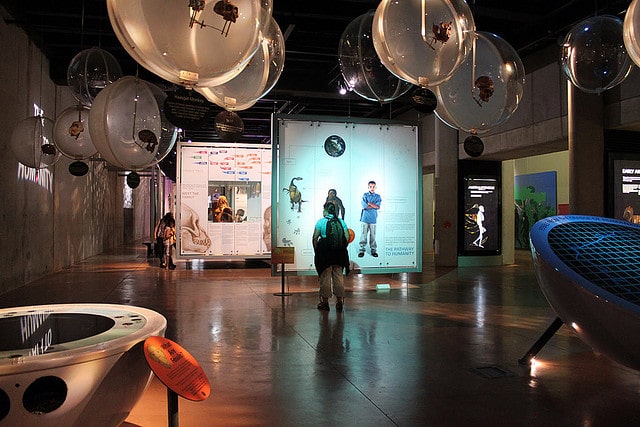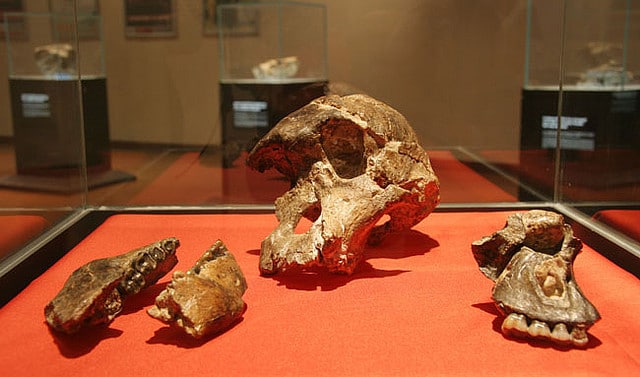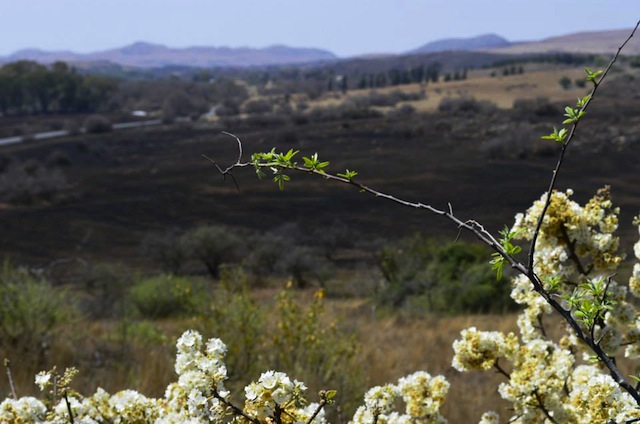The ancient world. Typically, this term brings to mind places like Egypt, Israel, Turkey and Greece; however, many findings show the birthplace of civilization is actually Africa.
During a visit to the Origins Centre (located on the University of Witwatrersand campus) in Johannesburg, I had my mind completely blown as I perused exhibits showing how gold, diamonds, artwork and even human genes all originated in Africa. In fact, the oldest known possible hominid ancestor of modern human beings — which is 7 million years old — was found in Chad in 2001.
As soon as you walk through the door of the museum you’ll see a piece of modern art depicting an Afrocentric map made of a shiny metal material. The map shows Africa in the very center, giving the viewer the idea the continent is the center of the world.
As you continue on through the institution there are a number of interesting exhibits, for example, a chronological display of ancient tools from different cultures, re-creations of human skulls found throughout Africa and an exhibit depicting a timeline of the Earth’s layers from each continent and what has been found overtime to help analyze the change of culture (for North America think coke bottles and McDonalds bags in 2013 where there were once clay and stone tools).
There are also a number of exhibits dedicated to the San people, the indigenous hunter-gatherer peoples of South Africa. The San are a very spiritual group, believing in spirits and other realms even before the birth of Christianity. Medicine men would do special trance dances to help ail the sick, often drawing their visions in Africa rock art, the oldest art form in the world.

While the Origins Museum gives excellent background information, heading to the Cradle of Humankind right outside of Johannesburg allows you to actually see and explore where it all began. In the Cradle of Humankind Visitor Centre, called Maropeng, interactive exhibits, games, quizzes, film clips and an indoor boat ride through time educate you in a fun way. Visitors gain insight on the origins and evolution of humans, the impact people have on the Earth, sustainability, and, most importantly, an important discovery by Charles Darwin proving that Africa — specifically the Cradle of Humankind — was the birthplace of modern humans, and that through their lineage everyone comes from Africa.
When Darwin, a comparative anatomist, visited South Africa in 1836, he was mostly impressed with the exotic animals — quagga, wildebeest, hartebeest and other quadrupeds — which were larger than any he had ever seen. Darwin also took note of the similarity between the skulls of chimpanzees and gorillas to humans — having more in common to people than even other primates.
As chimpanzees and gorillas were only found in Africa, he surmised that Africa was the continent from which man originated. It’s important to note Darwin wasn’t suggesting humans evolved from gorillas and chimpanzees, but instead that they shared a common ancestor, a near-human that lived about 3 to 2 million years ago which we now know as Australopithecus Africanus.
In the 47, 000 hectares (116,139 acres) encompassing the Cradle of Humankind there exist 13 excavated paleontological sites, with many important archeological discoveries being made at the site. In fact, over 1,000 hominid fossils have been discovered, meaning that before there were modern humans we were evolving in this area.
One particularly important discovery was an Australopithecus Africanus skull nicknamed Mrs. Ples — whose gender has never been determined — said to be 2.3-million years old. Another is an almost-complete Australopithecus skeleton called “Little Foot,” believed to be 3.3 million years old. A visit to Sterkfontein Caves in the Cradle of Humankind allows you to see where Little Foot was discovered, believed to have fallen through a natural opening at the top of the cave and fallen to his death, and where the skull of Mrs. Ples was recovered.
To further prove the point of Africa as the birthplace of humankind, the earliest species from the Homo genus is homo habilis, or “handy man,” which was discovered 2 million years ago on the continent, specifically Tanzania.
This being is believed to have been the first to create stone tools, which is what most likely helped homo habilis to live for half a million years through the Ice Age, as he was able to adapt to Earth’s changes. And from there, homo sapiens, the modern humans, began to emerge in Africa. These beings used their ability to create tools, think symbolically, communicate and create culture to travel to other countries, spread throughout the world and continue living through today.
The cranium of an Australopithecus africanus discovered in 1989 at Sterkfontein Caves in the Cradle of Humankind. Photo courtesy of Cradle of Humankind. Second photo credit: Walking through the Pathway to Humanity exhibit at Maropeng. Photo courtesy of flowcomm.

Jessica Festa is the editor of the travel sites Jessie on a Journey (http://jessieonajourney.com) and Epicure & Culture (http://epicureandculture.com). Along with blogging at We Blog The World, her byline has appeared in publications like Huffington Post, Gadling, Fodor’s, Travel + Escape, Matador, Viator, The Culture-Ist and many others. After getting her BA/MA in Communication from the State University of New York at Albany, she realized she wasn’t really to stop backpacking and made travel her full time job. Some of her most memorable experiences include studying abroad in Sydney, teaching English in Thailand, doing orphanage work in Ghana, hiking her way through South America and traveling solo through Europe. She has a passion for backpacking, adventure, hiking, wine and getting off the beaten path.










